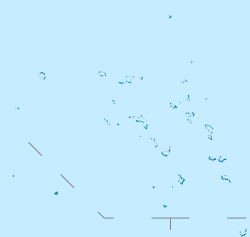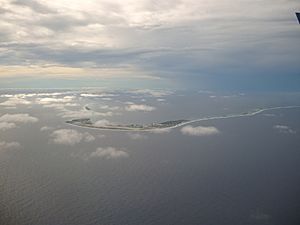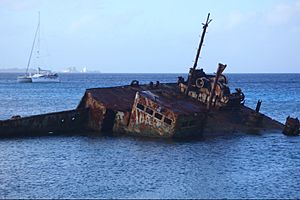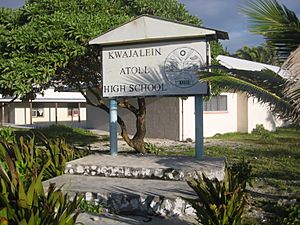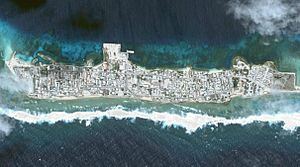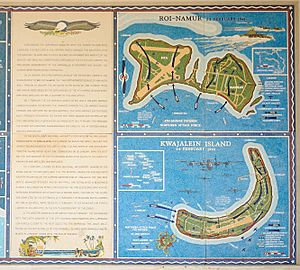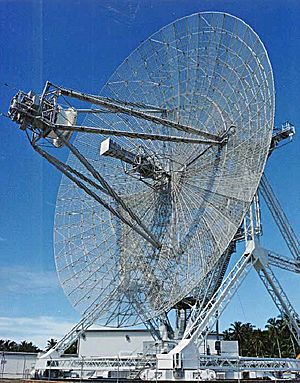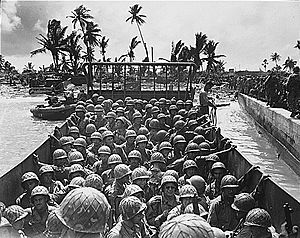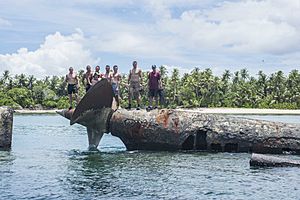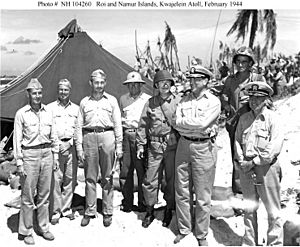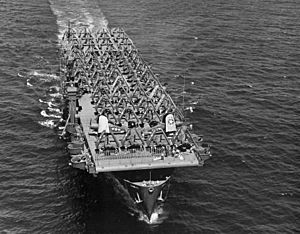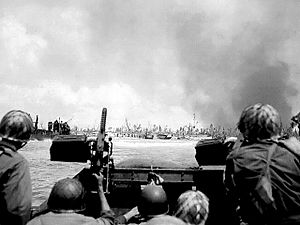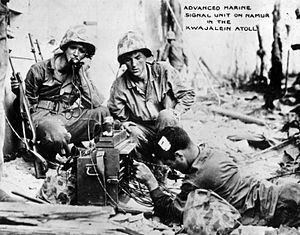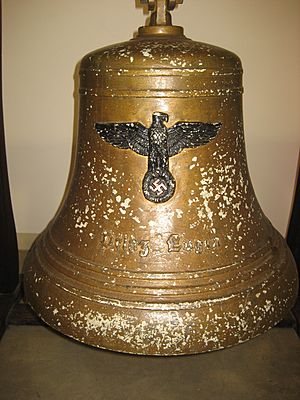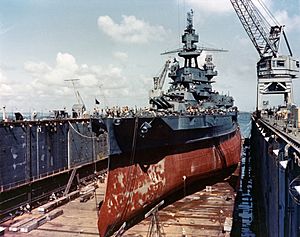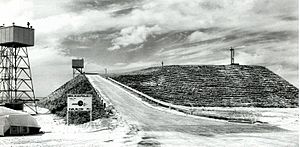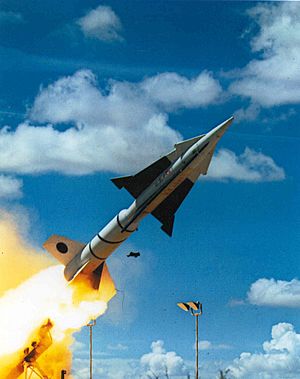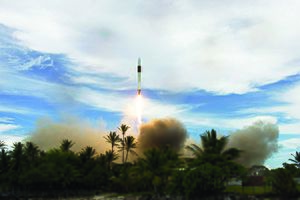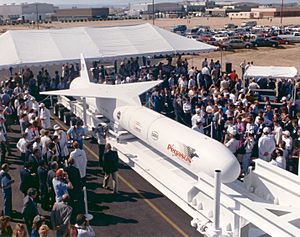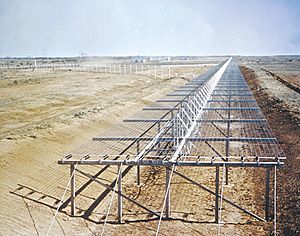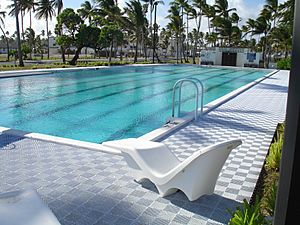Kwajalein Atoll facts for kids
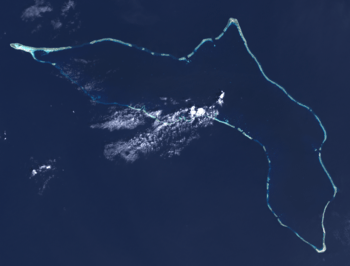
Landsat satellite image of Kwajalein Atoll
|
|

Map from National Atlas of the United States
|
|
| Geography | |
|---|---|
| Location | North Pacific Ocean |
| Coordinates | 8°43′N 167°44′E / 8.717°N 167.733°E |
| Archipelago | Ralik |
| Administration | |
Kwajalein Atoll is part of the Republic of the Marshall Islands (RMI). The southernmost and largest island in the atoll is named Kwajalein Island, which its majority English-speaking residents (about 1,000 mostly U.S. civilian personnel) often called by the shortened name, Kwaj. The total land area of the atoll amounts to just over 6 square miles (16 km2). It lies in the Ralik Chain, 2,100 nautical miles (3900 km) southwest of Honolulu, Hawaii.
The US Navy has hosted a naval base on Kwajalein Island, the southernmost part of the atoll, since World War II. It was the final resting place of the German cruiser Prinz Eugen after it survived the Operation Crossroads nuclear test in 1946. In the late 1950s, the US Army took over the base as part of their Nike Zeus anti-ballistic missile efforts, and since then the atoll has been widely used for missile tests of all sorts. Today it is part of the Ronald Reagan Ballistic Missile Defense Test Site, with various radars, tracking cameras, missile launchers and many support systems spread across many islands.
Contents
Kwajalein Island
Kwajalein is one of the world's largest coral atolls as measured by area of enclosed water. Comprising 97 islands and islets, it has a land area of 16.4 km² (6.33 mi²) and surrounds one of the largest lagoons in the world, with an area of 2174 km² (839 mi²). The average height above sea level for all the islands is about 1.8 metres (5 ft 11 in).
The atoll was formed from volcanoes on the seabed from 165–76 mya. When the lava buildup became large enough, the land rose from beneath the sea. It cannot be determined how far above sea level, the original land rose. The coral started growing about 56 mya (million years ago)
The atoll is 2,100 miles (3,400 km) from Honolulu, 2,000 miles (3,200 km) from Australia, and 2,100 miles (3,400 km) from Japan. Kwajalein Island is about 500 miles (800 km) north of the equator.
Kwajalein Island is the southernmost and largest of the islands in the atoll. To enlarge the island, the Americans placed fill at both the northwestern part of the island above the pier (within the atoll, by 1953), the northern part extending towards Ebeye, and the southwestern parts of the island (by 1970). The northern extension was used for housing, the remainder for industrial purposes.
Kwajalein Island's population is about 1,000, mostly made of Americans with a small number of Marshall Islanders and other nationalities, all of whom require express permission from the U.S. Army to live there. Some 13,500 Marshallese citizens live on the atoll, most of them on Ebeye Island.
Because of the Battle of Kwajalein of World War II, the lagoon contains dozens of wrecks of ships, and several aircraft. Most of the ships were merchant vessels.
There are two airbases and three airstrips on Kwajalein Atoll.
The water temperature averages 81 °F (27 °C) degrees. Underwater visibility is typically 100 feet (30 m) on the ocean side of the atoll. On Kwajalein Island the primary mode of personal transportation is the bicycle.
Ebeye Island
Ebeye is about 4.5 miles (7.2 km) north of easten end of Kwajalein Island. It is not part of the Reagan Test Site; it is a Marshallese island-city with shops, restaurants and an active commercial port. It is the administrative center of the Republic of the Marshall Islands at Kwajalein Atoll and the Kwajalein Atoll Local Government (KALGOV).
It has the largest population in the atoll, with approximately 13,000 residents living on 80 acres (320,000 m²) of land. Inhabitants are mostly Marshall Islanders but include a small population of migrants and volunteers from other island groups and nations.
Ebeye is one of the most densely populated places in the world. Many of its residents live in poverty. A coral reef (visible and able to be traveled at low tide) links them to Kwajalein and the rest of the outside world. A causeway at the northern end of the island provides a roadway that connects to several other islands, forming a chain of inhabited islands about 10 kilometres (6.2 mi) long.
Roi-Namur Island
Roi-Namur is the northernmost island in the atoll, located some distance north of Kwajalein. It has several radar installations and a small residential community of unaccompanied US personnel who deal with missions support and radar tracking.
Japanese bunkers and buildings from World War II are in good condition and preserved. Roi and Namur were originally separate islets that were joined by a causeway built mainly by Korean conscripted laborers working under the Japanese military.
There is a significant indigenous Marshall Islander workforce that commutes to Roi-Namur from the nearby island of Enniburr, much like workers commute from Ebeye to Kwajalein. These workers are badged and have limited access to the island like their counterparts on Kwajalein, although access is granted for islanders who need to use the air terminal to fly to Kwajalein.
Roi-Namur used to be four islands: Roi, Namur, Enedrikdrik (Ane-dikdik), and Kottepina. The pass between the islands was filled with sand that was dredged from the lagoon by both Korean laborers working for the Japanese and American between 1940 and 1945. After the war, the resulting co-joined islands were renamed Roi-Namur.
History
Kwajalein Atoll was an important cultural site to the Marshallese people of the Ralik chain. Kwajalein island was the site of an abundant flowering zebra wood tree. This was thought to have spiritual powers. Marshallese from other islands came to gather the "fruits" of this tree.
The first recorded sighting of Kwajalein by Europeans was during the Spanish expedition of Ruy López de Villalobos in January 1543. The atoll was charted as Los Jardines (The Gardens) because of its fresh appearance and trees.
The atoll came under the control of Spain but was largely ignored by European powers during the 17th and 18th centuries except for some short-lived missionary expeditions.
In 1828–1829, Russian Navy captain Ludwig von Hagemeister made his final circumnavigation on the ship Krotky. During this journey, he surveyed the Menshikov Atoll (Kwajalein) in the Marshall Islands, plotting it on the map and specifying the location of some other islands.
In early November, 1875, a typhoon resulted in an 8 feet (2.4 m) storm surge, drowning everyone on Kwajalein Island.
Following the Carolines incident in 1885, Imperial Germany gained control over the Marshall Islands from Spain in 17 December 1885.
The earliest-known Japanese record of Kwajalein and the Marshall Islands appears in the writings of Suzuki Keikun, who was sent to the Marshall Islands in 1885 to investigate a Japanese shipwreck.
At the outbreak of World War I in Europe, Japan joined the Triple Entente and seized the Marshall Islands against only token resistance. In 1922 the islands were placed under Japanese administration as a League of Nations Mandate. The islands of the Kwajalein Atoll, especially the main island, served as a rural trading outpost managed by Japanese civilians until the beginning of World War II in the Pacific in December 1941.
There was some Japanese settlement in Kwajalein Atoll, consisting of mostly traders and their families who worked at local branches of shops headquartered at nearby Jaluit Atoll where Japanese civilians numbered in the several hundreds to nearly 1,000 at the height of the Japanese administration.
With the establishment of Kwajalein's public school in 1935, school teachers were sent to the island from Japan. Most Marshall Islanders who recall those times describe a peaceful time of cooperation and development between Japanese and Marshallese.
In the late 1930s, Japan began to centralize military power in Micronesia in line with its expansionism into the south and throughout Oceania. This was a radical break with the League of Nations Mandate under which the islands had been peacefully administered.
Korean forced laborers (see Korea under Japanese rule) were sent throughout the Pacific beginning in the early 1940s, under strict orders from local Japanese-controlled city offices throughout Korea. Over 10,000 were sent to the Micronesia (Nanyo Gunto) area alone—mostly from the southernmost provinces of Korea—and thousands were sent to the Marshall Islands.
In Kwajalein, Koreans were placed in battalions and other specialized groups, sometimes with Marshallese, to build fortifications throughout the atoll. Whenever there were American air raids, the mainly Korean construction teams had to work night and day to fill the holes that American bombs had made.
A second wave of Japanese naval and ground forces was dispatched to Kwajalein in early 1943 from the Manchurian front, most of whom were between the ages of 18 and 21 and had no experience in the tropics. These young soldiers were poorly trained, were mostly in the army, and the supply ships that were meant to provide them with food rations were sunk by Americans.
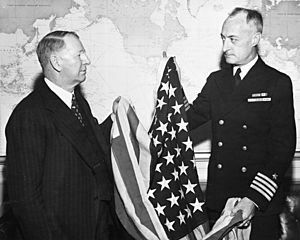
They had a very rough existence on Kwajalein and often succumbed to illness like dengue fever and dysentery—as did many of the laborers. As the tempo of military ideology increased, soldiers at Kwajalein became harsher and more violent toward Marshall Islanders, whom they often suspected of spying for the Americans.
After the war, a US Naval War Crimes court tried several Japanese naval officers here for war crimes committed elsewhere. At least one was condemned to death.
American occupation
On January 31, 1944, the 7th Infantry Division, headed by the 111th Infantry Regiment performed an amphibious assault on Kwajalein. On February 1, 1944, Kwajalein was the target of the most concentrated bombardment of the Pacific War. Thirty-six thousand shells from naval ships and ground artillery on a nearby islet struck Kwajalein. American B-24 Liberator bombers aerially bombarded the island, adding to the destruction.
Of the 8,782 Japanese personnel deployed to the atoll (including Korean slaves), 7,870 "Japanese" were killed.
Additionally, while many of the native Marshallese successfully fled the island in their canoes just before the battle, an estimated 200 were killed on the atoll during the fighting. Kwajalein was one of the few locations in the Pacific war where indigenous islanders were recorded to have been killed while fighting for the Japanese.
On February 6, 1944, Kwajalein was claimed by the United States and was designated, with the rest of the Marshall Islands, as a United Nations Trust Territory under the United States.
U.S. military installation
After the war ended, the United States used it as a main command center and preparation base in 1946 for Operation Crossroads, the first of several series of nuclear tests (comprising a total of 67 blasts) at the Marshall island atolls of Bikini and Enewetak.
Significant portions of the native population were forced to relocate as a result of American weapons testing and military activity in the islands between 1945 and 1965.
The German heavy cruiser Prinz Eugen was towed to Kwajalein from Bikini Atoll after the Operation Crossroads nuclear tests. It developed a leak, was towed out, and sank in the lagoon.
The USS Pennsylvania was sunk in the ocean off Kwajalein Atoll after being exposed during atomic bomb testing on 10 February 1948.
In 1964, when the United States initiated its Anti-ballistic missile testing program with the Nike Zeus program in Kwajalein Atoll, authorities moved the remaining Marshall Islanders who lived scattered throughout the atoll to the small shantytown of Ebeye which had been erected with plywood housing by American contractors.
With the end of the Cold War and a decreased threat of nuclear attack, many defense programs were canceled in the early 1990s.
21st century
With the election of Barack Obama to the presidency of the United States, the new administration of the Marshall Islands, and the looming deadline for signing the Land Use Agreement (LUA), at the end of 2008, President Litokwa Tomeing wrote a letter to George W. Bush asking that the deadline for the LUA be lifted. Within a day of the expiration of this LUA deadline, the United States agreed to shift this deadline back another five years.
The U.S. Army Garrison Kwajalein Atoll (USAG-KA) installation has been downsizing, in part because of budget constraints and technological improvements (such as a new trans-oceanic fiber-optic cable) that will allow the testing range to be operated extensively from sites in the United States, thus minimizing operation costs and the need for on-site workers or residents.
Recently the American population of the Kwajalein installation has dropped dramatically. The aluminum-sided trailers that housed the bulk of the contractor population are being removed from the main island. Nevertheless, the enormous investment in these new technologies and recent statements by Army leadership indicate that the United States is committed to remaining in the Marshall Islands at Kwajalein Atoll for the foreseeable future.
Kwajalein Atoll has been leased by the United States for missile testing and other operations.
SpaceX updated facilities on Omelek Island to launch its commercial Falcon 1 rockets. The first successful Falcon 1 orbital space launch from Omelek was conducted in 2008. It could launch Falcon 9 rockets into polar and geosynchronous orbit. Due to a disagreement about building a new launch pad on Omelek SpaceX moved their main facilities to the US and no longer uses the facilities in the atoll.
Since 2000, Kwajalein has become one of five preferred locations from which Pegasus rockets can be launched into equatorial orbit. Kwajalein and Roi-Namur are the main islands used by the U.S. personnel.
Of the 97 islands, 11 are leased by the United States. They are part of the Ronald Reagan Ballistic Missile Defense Test Site (RTS), formerly known as Kwajalein Missile Range. The lease is active from 2006–2066, with an option to renew for another 20 years.
RTS includes radar installations, optics, telemetry, and communications equipment, which are used for ballistic missile and missile-interceptor testing, and for space operations support. Kwajalein island hosts the $914 million Space Fence radar, which tracks satellites and orbital debris.
Kwajalein has one of five ground stations used in controlling the RTS range, which also assist in the operation of the Global Positioning System (GPS) navigation system.
Recreation
Kwajalein Island has several recreational accommodations, including two saltwater pools, multiple tennis courts, racquetball courts and basketball courts as well as playing fields for baseball, soccer, and other sports.
The Corlett Recreational Center (CRC) is on the northeast side of the island and features several rooms for use by inhabitants as well as a full-size, indoor court where community and youth basketball, volleyball and indoor soccer can be played.
The island features a nine-hole golf course near the airport, a bowling alley, libraries, a fitness center and two movie theaters. Inhabitants can rent boats for water skiing and fishing at the Kwajalein marina. Residents spear fish, deep-sea fish and scuba dive. The island also has a food court with a Subway, Burger King, and American Diner, as well as a bar for evening drinking and relaxation.
Images for kids
See also
 In Spanish: Kwajalein para niños
In Spanish: Kwajalein para niños


